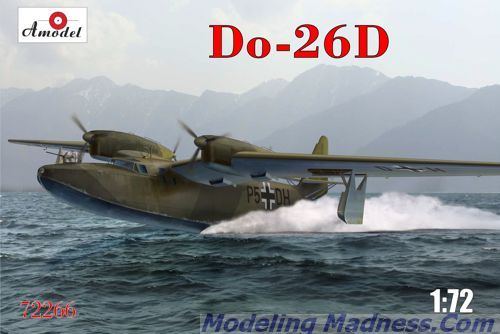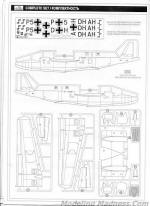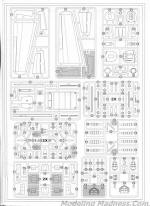
Amodel 1/72 Do-26D
| KIT #: | 72266 |
| PRICE: | $75.00 fro www.coopersmodels.com |
| DECALS: | Two options |
| REVIEWER: | Scott Van Aken |
| NOTES: | Short run kit |

| HISTORY |
The elegant Do 26, sometimes referred to as the "most beautiful flying-boat ever built", was of all-metal construction. The hull had a central keel and a defined step; the wings were of gull wing configuration, the outer sections being equipped with fully retractable narrow stabilising wing-floats, instead of Dornier's famous "water-wing" sponsons extending from the lower hull for lateral stabilization.
Its four engines, Junkers Jumo 205C diesels, were mounted in tractor/pusher pairs in tandem nacelles located at the joint between the dihedral and horizontal wing sections. The rear (pusher) engines could be swung upwards through 10° during take-off and landing, to prevent contact between the three-blade airscrew and water spray created by the forward propellers.
The tail unit was of conventional design, comprising a horizontal tailplane and a single, vertical fin with rudder. The first three planes were built for the national airliner Deutsche Lufthansa, for mail service between Hamburg and New York.
All three Deutsche Lufthansa aircraft were impressed into military service in 1939 at the outbreak of World War II, as P5+AH, P5+BH and P5+CH respectively.
Three other Do 26 aircraft (V4 - V6) were built as Do 26 C for the Luftwaffe with the more powerful 648 kW (880 hp) Junkers Jumo 205D engines; the original three aircraft were similarly converted for military service. Armament consisted of one 20 mm MG 151/20 cannon and three 7.92 mm (.312 in) MG 15 machine guns.
The Do 26s saw service in April and May 1940 in the Norwegian Campaign, transporting supplies, troops and wounded to and from the isolated German forces fighting at Narvik under the command of General Eduard Dietl. During this campaign three of them were lost:
On 8 May 1940, V2 (ex Seefalke) was shot down by three Blackburn Skuas of 803 Naval Air Squadron, Fleet Air Arm, operating from the Royal Navy aircraft carrier HMS Ark Royal while carrying 18 Gebirgsjägers to the Narvik front. After a running fight V2 crash-landed in Efjorden in Ballangen. Siegfried Graf Schack von Wittenau, the crew and 18 soldiers, were captured in bloody fighting with Norwegian forces. One of the Skuas, flown by future Fleet Air Arm fighter ace Sub-Lieutenant Philip Noel Charlton, was hit by return fire from V2 and made an emergency landing at Tovik near Harstad.
Then, on 28 May 1940, both V1 (ex Seeadler) and V3 (ex Seemöwe) were set ablaze with gunfire and sunk at their moorings at Sildvik in Rombaksfjord near Narvik, when discovered and attacked by three Hawker Hurricanes of No. 46 Squadron RAF led by the New Zealander Flight Lieutenant (later Group Captain) P.G. "Pat" Jameson,DSO, DFC and bar shortly after landing. Three mountain guns destined for the German forces fighting in the mountains east of Narvik were lost with the destruction of V1 and V3, whilst one gun was recovered from one of the aircraft before it was lost.
V5 was lost on 16 November 1940, killing its crew, after being launched at night from the catapult ship Friesenland in Brest, France. The fate of V4 and V6, which in 1944 were still assigned to the Test Unit (German: Erprobungsstelle) in Travemünde, is unclear.
| THE KIT |

 This is one of Amodel's larger kits, measuring over 14.5
inches from nose to tail. While it is short run, it is well done short run. The
engraved detail is pretty nicely done and I did not see any of the 'panel line
fading' one can often find in other kits of this type. Most of the sprues are
rather small so aside from the fuselage, there is a lot of room in the box.
Amodel has also kitted a Lufthansa version so there are parts in this kit that
will not be used. There are a total of 18 sprues, including two clear ones.
This is one of Amodel's larger kits, measuring over 14.5
inches from nose to tail. While it is short run, it is well done short run. The
engraved detail is pretty nicely done and I did not see any of the 'panel line
fading' one can often find in other kits of this type. Most of the sprues are
rather small so aside from the fuselage, there is a lot of room in the box.
Amodel has also kitted a Lufthansa version so there are parts in this kit that
will not be used. There are a total of 18 sprues, including two clear ones.
The cockpit includes a radio operator/navigator's position as well as two additional seats in the radio room. Up front is a pilot and co-pilot's position. This has seats and control sticks/wheels along with an instrument panel. No rudder pedals and no seat belts. I'd use those for bombers if you are going to put in aftermarket ones. There is also another compartment near the middle of the fuselage, and a tail 'tunnel' gun position.
Moving to the wings, all of the flap and aileron hinges are separate pieces. Each of the wing mounted radiators for the engines (and there are four) are built up of five pieces each. The float wells consist of four pieces that box it in. While the rudder is a separate piece, that is not the case for the elevators and ailerons. I'm thinking that these were normally locked in place while on the water, except for take-off and landing. There are braces for the tailplanes. These are butt fit onto stubs on the fuselage and stabs.
For defensive armament, there are three major positions. One is a five piece nose turret and fits on the front. This can be attached after painting. There are also a pair of upper fuselage blisters as on a Catalina. When one installs all the fuselage windows early in the build, there are two forward gun positions. Basically a hole in the window for a machine gun.
Back at the wings, one assembles the five main pieces (three upper and two lower) first. Then the six piece engine nacelles are assembles along with their props and spinners. These are then attached to the upper wing. The wing floats are apparently to be modeled in the lowered position. I'm sure that if you wanted to do this kit in flight, you can easily glue them raised. A nice addition is a beaching dolly. This is probably the most complex part of the kit, comprising 45 parts.
 Instructions are nicely done and provide Humbrol paint
references. It is recommended that the interior be a medium grey, and I suppose
that for the markings provided, that would be appropriate. It is probably what
is known as Lufthansa grey. Markings are provided for two planes, neither of
which is a Do-26D. In fact, I could not find much info on the D variant.
According to the reference, aircraft v1 through v6 were militarized as Do-26C.
One set of markings is for the Do-26v1 and the other for the Do-26v4.
Instructions show the two aircraft painted in the maritime scheme of RLM
72/73/65. The decal sheet is nicely printed and quite matte. Swastikas are
provided in two parts.
Instructions are nicely done and provide Humbrol paint
references. It is recommended that the interior be a medium grey, and I suppose
that for the markings provided, that would be appropriate. It is probably what
is known as Lufthansa grey. Markings are provided for two planes, neither of
which is a Do-26D. In fact, I could not find much info on the D variant.
According to the reference, aircraft v1 through v6 were militarized as Do-26C.
One set of markings is for the Do-26v1 and the other for the Do-26v4.
Instructions show the two aircraft painted in the maritime scheme of RLM
72/73/65. The decal sheet is nicely printed and quite matte. Swastikas are
provided in two parts.
| CONCLUSIONS |
It is great to see this airplane being kitted. While not a major seaplane fan, this is one of sweetest looking ever done. Building this one should not be an issue if you have had a few kits like this under your belt. While Amodel is still short run, they have improved quite a bit over the years. I'm looking forward to getting this one going here in the near future.
| REFERENCES |
http://en.wikipedia.org/wiki/Dornier_Do_26
September 2014 Thanks to
www.coopersmodels.com for the preview kit. You can
get yours at the link. If you would like your product reviewed fairly and fairly quickly, please
contact
the editor or see other details in the
Note to
Contributors.